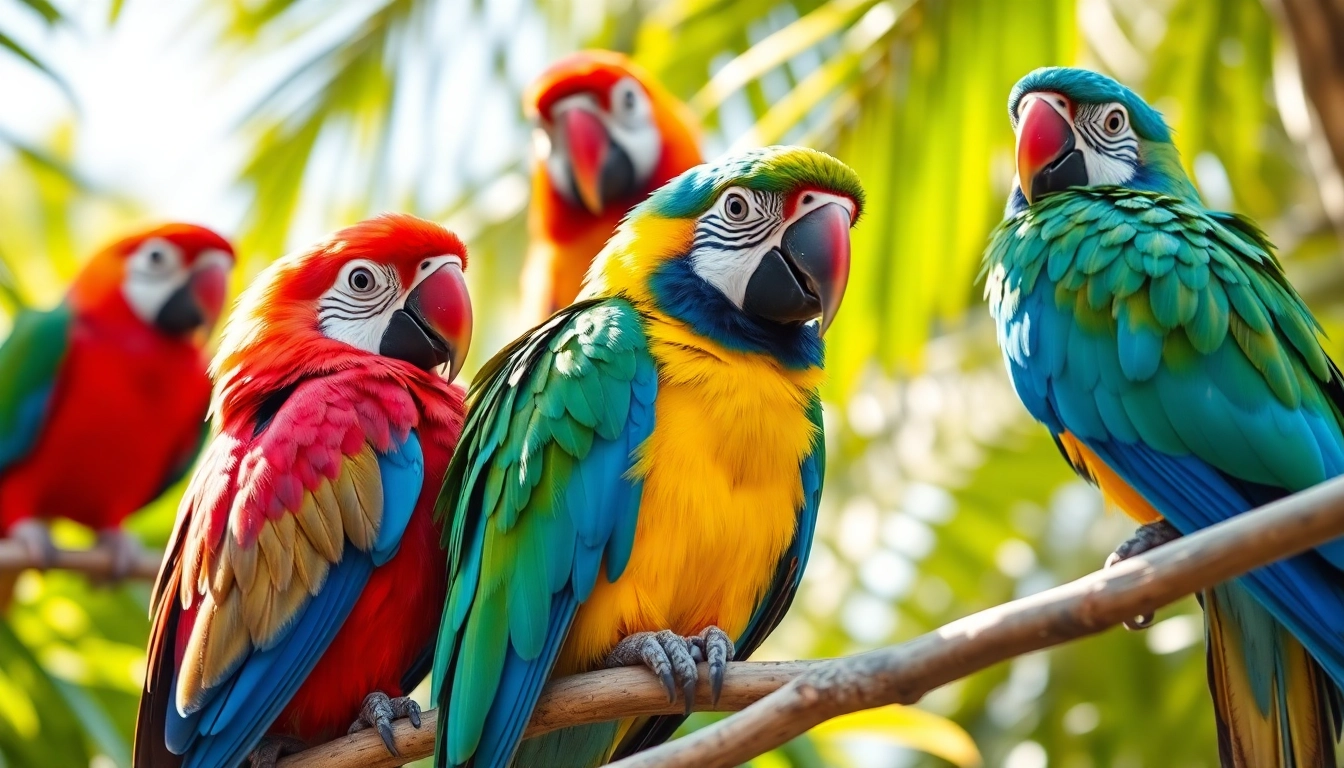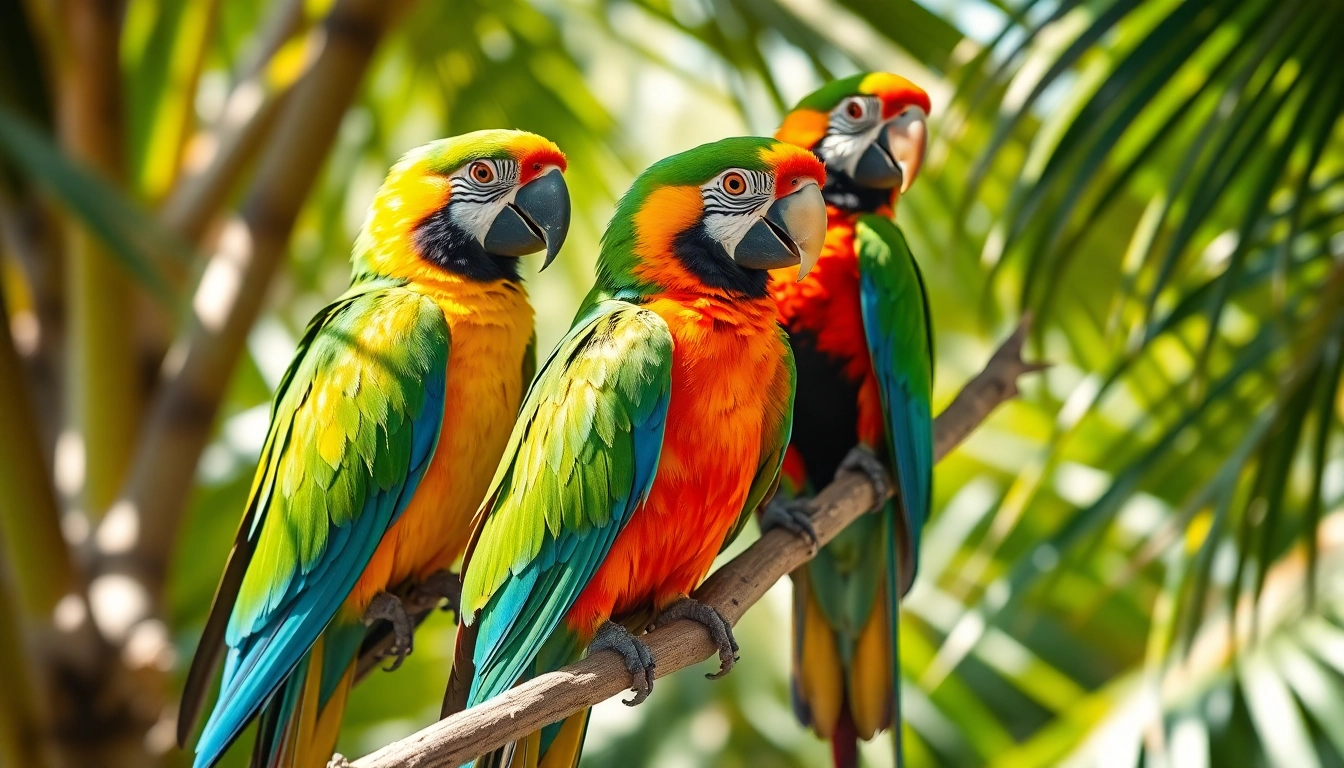Introduction to Parrots: Characteristics and Global Distribution
Parrots, scientifically classified within the order Psittaciformes, are among the most vibrant and intelligent birds on Earth. Known for their striking plumage, remarkable mimicry, and social behaviors, these birds have captivated humans for centuries. With approximately 410 species spread across 101 genera, parrots are predominantly found in tropical and subtropical regions worldwide, from the lush rainforests of South America to the islands of Madagascar and the islands of Australasia. They are often associated with vibrant ecosystems, playing vital roles in seed dispersal and forest regeneration.
Their strong, curved beaks serve multiple purposes: cracking nuts, eating fruits, and grooming feathers. Parrots’ upright stance and clawed feet are adaptations that facilitate their arboreal lifestyles, allowing them to navigate complex canopies with agility. Understanding their physical traits and distribution patterns provides insights into their ecological importance and the conservation challenges they face today. To delve deeper into their fascinating diversity and global spread, explore the detailed parrots overview.
What Defines a Parrot: Key Physical Features
Parrots possess a set of distinctive physical features that not only make them visually appealing but also highly adapted to their environments. Their most notable characteristic is their strong, curved beak, which is both a specialized feeding tool and a means of social interaction. This beak enables parrots to crack hard nuts and seeds, chew fibrous plant material, and manipulate objects, highlighting their dexterity and intelligence.
Their upright stance is complemented by a pair of strong, clawed feet, typically with two toes pointing forward and two backward (zygodactylous), allowing superb grip and climbing abilities. The vibrant plumage varies widely among species but generally includes a spectrum of bright reds, blues, greens, yellows, and other bold hues, which play roles in mating displays and species recognition.
Parrots also have a relatively large brain size relative to their body, correlated with high intelligence levels. Their eyes are positioned to give excellent binocular vision, which is vital for navigating through dense foliage. Key attributes that define parrots include:
- Strong, curved beak for feeding and social signals
- Arboreal feet for climbing and grasping
- Vivid, colorful feathers
- Large brain associated with cognitive abilities
- Vocal apparatus capable of mimicry and complex sounds
Parrot Habitats Around the World
The natural habitats of parrots are as diverse as their species, spanning tropical rainforests, dry savannas, mountainous regions, and even some arid areas. They predominantly occupy regions that provide abundant food sources like fruits, nuts, seeds, and nectar. Tropical forests in South America, Africa, and Australasia harbor the richest diversity of parrot species, with many endemic to specific islands or regions.
For instance, the Amazon rainforest is a renowned hotspot for parrot diversity, supporting species like the Scarlet Macaw and Amazon parrots. Madagascar offers a unique habitat for the critically endangered Kākāpō and other endemic species. The Australian continent hosts various cockatoos and corellas, often adapted to more open woodlands and grasslands.
Urbanization and deforestation have significantly altered many natural habitats, leading to declines in diverse parrot populations. Conservation efforts increasingly focus on preserving these habitats, establishing protected areas, and restoring degraded ecosystems to ensure species survival. Understanding habitat distribution is crucial for effective conservation strategies.
Popular Parrot Species and Their Unique Traits
Among the thousands of parrot species, several have gained fame for their distinctive behaviors, intelligence, or popularity as pets. Here, we highlight some of the most iconic species and what sets them apart.
Hyacinth Macaw (Anodorhynchus hyacinthinus)
The Hyacinth Macaw is the largest flying parrot, notable for its stunning cobalt-blue feathers and impressive size, weighing up to 3.7 pounds. Native to Brazil’s wetlands and woodlands, this species is critically endangered mainly due to the pet trade and habitat loss. Their intelligent and social nature makes them highly trainable but also prone to destructive behaviors if not properly stimulated.
Kākāpō (Strigops habroptila)
A flightless, nocturnal parrot endemic to New Zealand, the Kākāpō is notable for its owl-like appearance and critically endangered status, with only around 250 individuals remaining. It has a unique breeding strategy involving elaborate male displays to attract females, making it a symbol of conservation efforts.
Amazon Parrots
Known for their vibrant green plumage and exceptional talking abilities, Amazon parrots inhabit Central and South America. They are highly social and intelligent, often forming close bonds with humans in captivity. Their loud vocalizations and social nature make them both entertaining and challenging pets.
Cockatoos
Distinguished by their expressive crests and predominantly white or pink plumage, cockatoos are native to Australia and nearby islands. They are highly affectionate but require substantial mental stimulation, and their loud calls can be heard for miles.
Each species exhibits unique traits that influence their care requirements, behavioral tendencies, and conservation status, making it essential for potential owners and conservationists to understand their specific needs.
Understanding Parrot Behavior and Intelligence
Social Structures and Communication
Parrots are inherently social creatures, living in larges flocks in the wild to maximize safety and resource sharing. Their communication is complex, involving a rich array of vocalizations, body language, and visual signals. They use calls to establish territory, alert others to danger, and facilitate social bonds within flocks.
As intelligent birds, parrots can recognize mates, identify individual flock members, and even learn human speech. Their ability to mimic sounds and speech is a hallmark of their cognitive prowess, often used within their groups to reinforce social bonds.
Training and Mimicry Capabilities
Parrots’ brain structures allow them to learn sounds and words with remarkable accuracy. African grey parrots, in particular, are renowned for their advanced vocal skills and problem-solving abilities. Proper training involves patience, positive reinforcement, and engaging activities that challenge their minds.
They can learn hundreds of words or phrases, and some individual parrots have demonstrated understanding of concepts, numbers, and basic patterns. Training not only fosters communication but also reduces destructive behaviors caused by boredom.
Bonding with Owners: Signs of Affection
Parrots form strong bonds with their owners, often displaying signs of affection such as preening, cuddling, and seeking physical closeness. They may mimic personal sounds (like their owner’s voice or household noises) as acts of attachment.
Recognizing these behaviors helps owners nurture a healthy relationship and ensure the well-being of their feathered friends.
Parrot Care: Feeding, Housing, and Health
Dietary Needs and Nutritional Tips
An optimal diet is fundamental for maintaining a parrot’s health and longevity. Their diets should mimic their natural intake, including a variety of high-quality pellet mixes, fresh fruits, vegetables, nuts, and seeds. Fresh water should always be available.
Specific dietary considerations include avoiding processed human foods, chocolate, caffeine, and avocado, all of which are toxic to parrots. Regularly rotating food items prevents nutritional deficiencies and boredom.
Studies show that nutritional imbalances can lead to health issues like fatty liver disease, osteoporosis, and feather plucking. Incorporating calcium sources and ensuring a balanced calcium-to-phosphorus ratio is also critical.
Housing Tips for Happy, Healthy Parrots
Parrots need spacious cages that allow for climbing, stretching, and play. The cage should be made of non-toxic materials, with bar spacing appropriate for the species to prevent escapes or injuries. Perches of varying diameters and textures promote foot health.
Enrichment is vital; include toys, foraging opportunities, and perches placed at different heights. Regularly rotating toys prevents boredom and destructive behavior. Parrots thrive with daily supervised out-of-cage time in a safe environment.
Maintaining proper lighting, humidity, and temperature fosters a healthy environment, mimicking their natural habitats.
Common Health Issues and Prevention Strategies
Health concerns in parrots include respiratory infections, nutritional deficiencies, feather plucking, and bacterial or parasitic infestations. Regular veterinary checkups—preferably with an avian veterinarian—are essential.
Prevention involves a clean, stress-free environment, a balanced diet, and prompt attention to behavioral or physical changes. Recognizing early symptoms such as changes in droppings, feather condition, or activity levels ensures timely intervention.
Conservation and Challenges Facing Parrots
Threats from Habitat Loss and the Pet Trade
Parrots face significant threats from deforestation, habitat fragmentation, and the illegal pet trade. Forest clearing for agriculture, logging, and urban development has drastically reduced nesting and feeding grounds, leading to population declines.
The pet trade has fueled overharvesting of wild populations, particularly for highly desirable species like the Scarlet Macaw and African Grey. This unsustainable practice exacerbates their vulnerability, often driving species toward extinction.
Additionally, invasive species introduced through human activity can prey on eggs or compete for resources, further endangering native populations.
Global Conservation Efforts and Organizations
Protecting parrots requires coordinated international efforts. Organizations like the World Parrot Trust work to establish protected areas, rescue and rehabilitate confiscated parrots, and promote habitat restoration initiatives.
Legislation such as the Convention on International Trade in Endangered Species of Wild Fauna and Flora (CITES) regulates trade and seeks to prevent illegal exports. Several national parks and reserves serve as crucial sanctuaries for wild populations.
How to Support Parrot Preservation
Individuals can contribute by supporting reputable conservation organizations, avoiding purchasing parrots from illegal or unregulated sources, and educating others about the importance of habitat protection. Promoting captive breeding programs that emphasize conservation and ethical standards can help reduce pressure on wild populations.
Responsible ownership of pet parrots includes ensuring they are sourced ethically and that their needs are met to prevent them from being abandoned or surrendered, which can lead to neglect or illegal sale.
Choosing and Caring for Pet Parrots
Best Parrot Species for Beginners
Prospective owners should consider species’ size, temperament, lifespan, and care requirements. Good beginner parrots include budgerigars, lovebirds, and cockatiels, which are generally smaller, less demanding, and more manageable in typical household environments.
Larger parrots like Amazons, African Greys, or Macaws offer remarkable intelligence and companionship but demand greater commitment, space, and mental stimulation. Proper education before bringing any parrot home ensures a successful, lasting bond.
Legal and Ethical Considerations
Legally, many countries and states regulate the ownership, trade, and transport of parrots. Buyers should verify permits, licenses, and sources to ensure compliance with conservation laws. Ethically, prospective owners must understand the impact of their purchase, striving for captive-bred birds over wild-caught specimens.
Education and awareness are key; owning a parrot involves a long-term commitment that exceeds typical pet responsibilities. Ethical ownership includes providing enrichment, social interaction, and lifelong care.
Long-term Commitment and Responsible Ownership
Parrots are one of the longest-lived bird species, with many living 40-60 years or more. Responsible ownership requires planning for their long lifespan, including health care, proper diet, social needs, and environmental enrichment.
Neglecting these responsibilities can lead to behavioral issues, health problems, and early death. Owners should educate themselves thoroughly, seek guidance from avian veterinarians, and connect with established parrot communities for ongoing support.
In conclusion, parrots are extraordinary birds that enrich our lives with their intelligence, beauty, and social bonds. Proper understanding, care, and conservation efforts ensure they continue to thrive in the wild and as companions worldwide.



